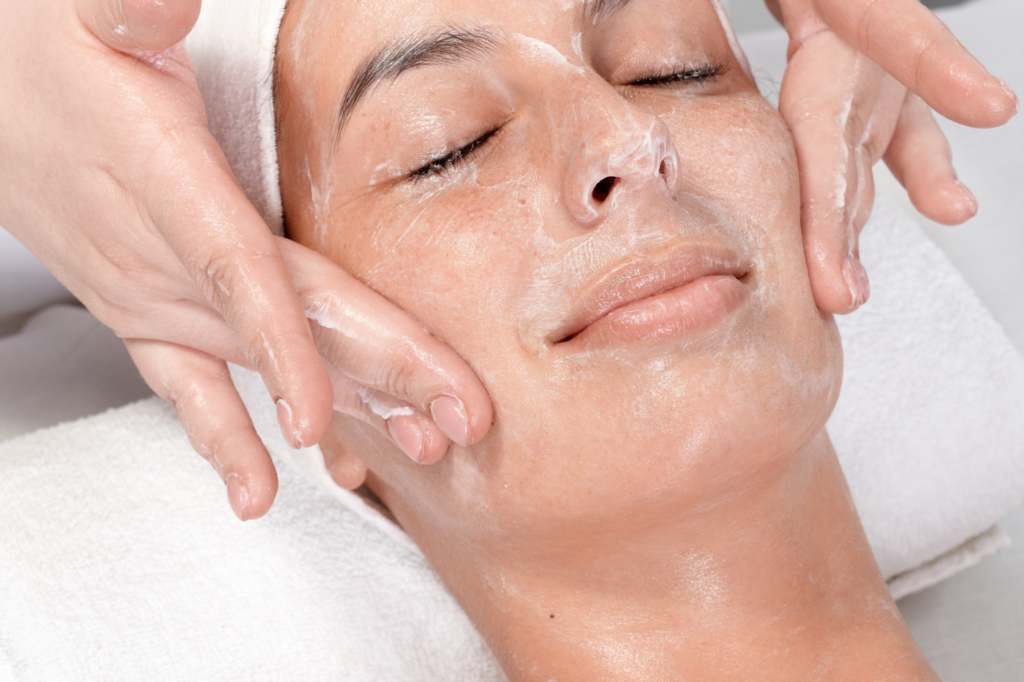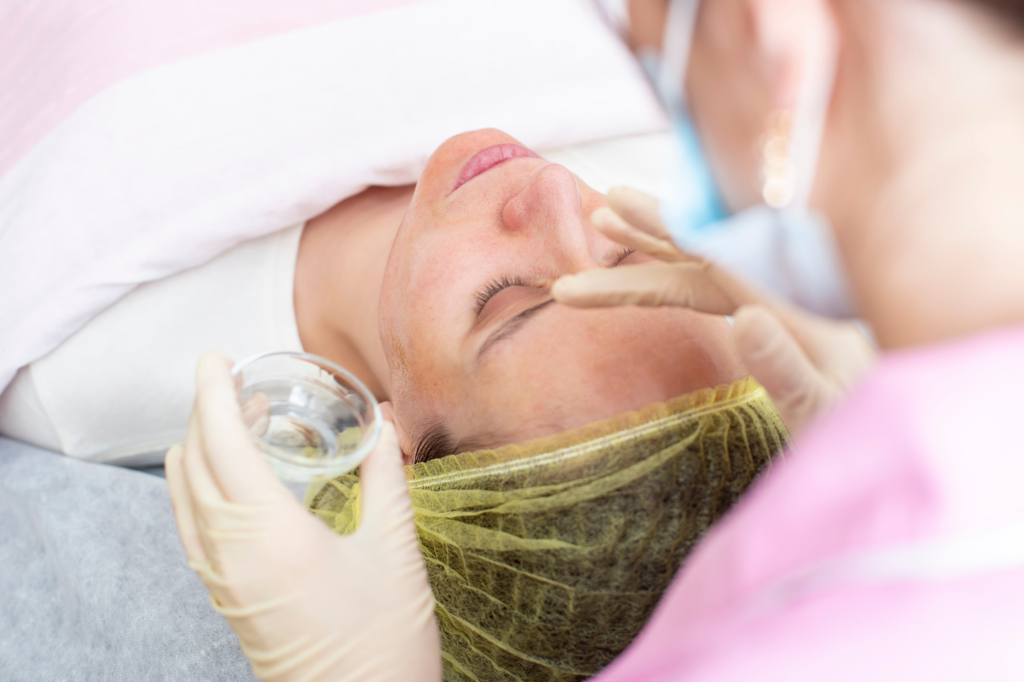I’ll be the first to acknowledge that for my more holistically-minded clients, chemical peels sound like the opposite of a natural beauty treatment. However, you might be surprised to learn from this functional dermatologist that chemical peeling can benefit both aging and acne-prone skin.
You can expect chemical peels to treat a number of skin issues like discoloration, acne scarring, pimples, and even texture changes. When it comes to the skin’s surface, there’s almost nothing they can’t do.
Here’s why you should give exciting exfoliants a chance.

Chemical Peels: What are they? How do they work?
Chemical peels are a topical skin treatment that exfoliates a layer of the skin using a chemical solution, stripping away damaged or old skin cells to reveal the fresh layer underneath. Chemical peels may cause minor stinging, burning, and redness that goes away as the new layer of skin heals.
Because they work on a deeper level, they are able to revitalize the skin’s texture, tone, scars, and pigment.
Is a chemical peel good for the skin? Yes, the correct chemical peel can totally resurface your skin, treating issues like:
- Aging and mature skin: chemical peels can treat wrinkles and fine lines
- Uneven texture and acne: sun damage, acne scars, and other scarring
- Uneven tone: hyperpigmentation, redness, and melasma
How do chemical peels work? Chemical peels work topically on the skin, penetrating past the topmost layer of skin, and eventually causing it to peel away. Their exfoliation causes resurfacing, bringing out a new top layer of skin.
Superficial vs. Medium-Depth vs. Deep Chemical Peels
These are the three types of chemical peels, and each has its own side effects, healing time, and fabulous results. While all three are topical treatments, there can be a large range in intensity and the amount of skin that peels away.
Here are the details on these three peel types from least to most potent:
- Superficial peels: these peels use “light” acids such as alpha-hydroxy acids (AHA) or beta-hydroxy acid (BHA) to exfoliate the outermost layer of the skin. The skin usually recovers in 4-7 days. Some superficial peels can be purchased over the counter, but more effective versions are available through your dermatologist.
- Medium-depth peels: these peels use agents like trichloroacetic or glycolic acid to penetrate both the outermost and middle skin layers. Recovery time for medium-depth peels usually ranges from 5-8 days, though redness will likely persist.
- Deep peels: these peels use a chemical solution of phenol or trichloroacetic acid to penetrate the middle layer of skin and remove large amounts of damaged skin cells. Because of the deep penetration of these peels, it may take 2-3 weeks to see the new skin layer, and redness can last longer.
 Benefits of Chemical Peels for Acne & Acne Scars
Benefits of Chemical Peels for Acne & Acne Scars
I’ve seen chemical peels create impressive benefits when treating acne and acne scars. Resurfacing the skin can unclog pores, create more even texture and color, stop breakouts, and brighten up dark spots.
Here are some of your most frequently asked questions.
- What chemical peel is best for acne? There is no perfect chemical peel that is best for acne, but there are several options available. I typically recommend acne peels that include BHA, which dissolves buildup inside the pores. salicylic acid peels, which can loosen dirt from pores, glycolic acid, which can reduce lesions and scarring, or Jessner’s peels, which can even skin tone and reduce scars.
- Do chemical peels help with acne? Yes, chemical peels can absolutely help with acne scarring, lesions, and clogged pores. Speak with your dermatologist about which type of peel can help with your treatment of acne.
- How much is a chemical peel for acne? How much a chemical peel for acne costs is determined by a few factors, including the provider and area where you live. Typically, they range between $150 or more for lasting results.
Benefits of Chemical Peels for Aging Skin
If you feel like your face is taking its cues from A Wrinkle in Time, a chemical peel may be able to help. Peels help the body produce more collagen, which fills in scars and wrinkles.
Here are the benefits of chemical peels for aging skin, according to your frequently asked questions:
- Can chemical peels reduce wrinkles? Yes, the resurfacing effects of a chemical peel can boost collagen production, filling in wrinkles and refreshing a mature skin type.
- Which acid is best for aging skin? The acids that are best for aging skin include glycolic acid, retin-a/tretinoin and other retinol treatments, hyaluronic acid, lactic acid, and TCA peels.
- Do chemical peels make you look younger? The right chemical peel can sweep away dead skin cells, reduce age spots, or minimize fine lines, making you look younger and enhancing your natural glow.
Should you do peels at home, or at the dermatologist?
When signs of acne or aging arise, many people turn to harsh exfoliating skin-care products to scrub away their concerns. However, this can do more harm than good. Physical exfoliants can trigger sebum production or damage mature skin that is slower to repair, exacerbating the issue.
The American Academy of Dermatology states that our understanding of chemical peels has advanced in the past 30 years, leading to better results than ever. We now know that the deeper the peel, the better results – but also, the more possible complications.
This is why it’s key to work closely with your dermatologist on what chemical peel for acne or aging is right for you. Troubleshooting and over-exfoliating at home can feed the problems you’re trying to treat. Head into the office for a truly impactful treatment.
How to Prepare for a Professional Chemical Peel
A chemical peel is nothing to fear, but it’s important to prepare your skin well. Before scheduling your peel, be sure to discuss any current medication with your dermatology provider. This will prevent any unwanted interactions. Additionally:
- 6 months in advance if needed: stop taking isotretinoin.
- 7-14 days in advance: stop using retinoids, facial scrubs or exfoliants, hair removal products like waxes and creams,
- The day of the peel: follow any other additional instructions your dermatologist has recommended and relax and enjoy your self-care moment
Aftercare for Chemical Peels
No matter what depth of chemical peel you’ve had, it’s crucial to follow your dermatologist’s instructions for aftercare. Here are some top tips:
- The new skin emerging after your peel is much more sensitive to UV rays, so use sun protection to avoid a sunburn that could cause permanent issues.
- Though it may be tempting to slather on the makeup to cover your flaking skin, resist the urge to apply any cosmetics!
- Be sure to closely follow your dermatologist’s aftercare instructions on washing and moisturizing, and avoid touching your face, tempting as it may be.
If you’re experiencing ongoing discomfort, try a cool fan to provide some relief, or an ice pack if your dermatologist approves. Remember, this won’t last forever, and your fresh skin will thank you.
Risks & Side Effects of Chemical Peels for Skin
It’s no secret that the side effects of chemical peels can include redness, burning or stinging, dryness, and light inflammation. However, here are a few cautionary notes about the more significant risks and side effects:
- Skin damage: Failure to take proper downtime and care after your peel can produce uneven skin tone and further scarring, so it’s important to take all aspects of aftercare seriously.
- Heightened risk of infection: Patients may experience a fungal or bacterial infection in rare cases. It’s also possible for those with herpes simplex to experience an outbreak after a peel.
- Organ damage: Deep peels that contain phenol may damage cardiac muscle, liver, or kidneys in very rare cases.
While these more serious side effects do happen, they’re extremely uncommon.
For aging or acne, a chemical peel can completely resurface the skin and provide significant results. Your chemical peel for acne before and after results will amaze you, and the same goes for aging.
Ask your dermatologist what type of peel is right for you, and meet your new skin soon.
Sources
- Soleymani, T., Lanoue, J., & Rahman, Z. (2018). A practical approach to chemical peels: a review of fundamentals and step-by-step algorithmic protocol for treatment. The Journal of clinical and aesthetic dermatology, 11(8), 21. Full text: https://www.ncbi.nlm.nih.gov/pmc/articles/PMC6122508/
- Brody, H. J., & Hailey, C. W. (1986). Medium‐depth chemical peeling of the skin: a variation of superficial chemosurgery. The Journal of dermatologic surgery and oncology, 12(12), 1268-1275. Abstract: https://pubmed.ncbi.nlm.nih.gov/3782600/
- Rendon, M. I., Berson, D. S., Cohen, J. L., Roberts, W. E., Starker, I., & Wang, B. (2010). Evidence and considerations in the application of chemical peels in skin disorders and aesthetic resurfacing. The Journal of clinical and aesthetic dermatology, 3(7), 32. Full text: https://www.ncbi.nlm.nih.gov/pmc/articles/PMC2921757/
- Lee, K. C., Wambier, C. G., Soon, S. L., Sterling, J. B., Landau, M., Rullan, P., … & Society, I. P. (2019). Basic chemical peeling: Superficial and medium-depth peels. Journal of the American Academy of Dermatology, 81(2), 313-324. Abstract: https://www.jaad.org/article/S0190-9622(18)33049-4/fulltext
- Landau, M. (2007). Cardiac complications in deep chemical peels. Dermatologic surgery, 33(2), 190-193. Abstract: https://pubmed.ncbi.nlm.nih.gov/17300604/
- Starkman, S. J., & Mangat, D. S. (2019). Chemical peels: deep, medium, and light. Facial Plastic Surgery, 35(03), 239-247. Abstract: https://europepmc.org/article/med/31189196

